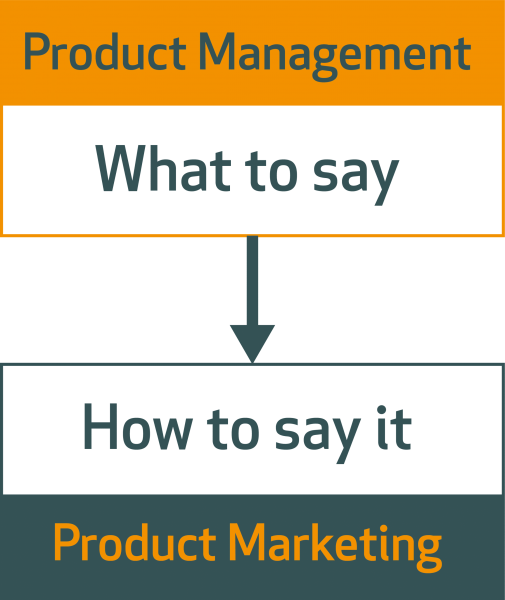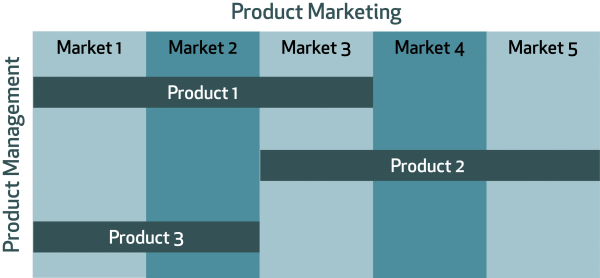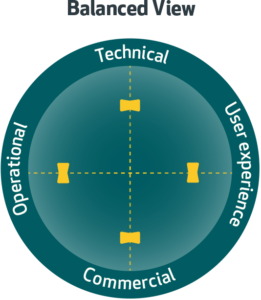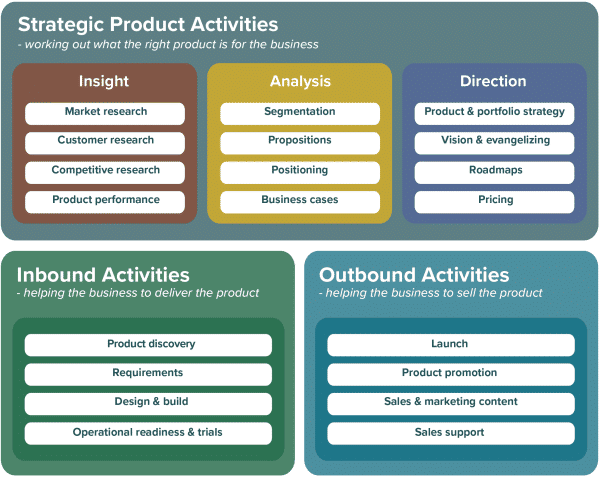This article explains Product Marketing. You can read all the articles in our Product Management Journal – Product Marketing by signing up for free here.
Is there an industry-standard definition for Product Marketing?

Well, like the mythical unicorn, you can look for it, but you’ll never find it. What makes a definition challenging is that the product marketing role is different from company to company.
In smaller companies, the role may not exist, and so the product marketing activities are picked up by someone in Marketing or by a product manager.
In larger companies, there may be product marketing people for each country or region, feeding their understanding of local markets into a central function.
A Product Marketing department may be part of Marketing, Sales, Product Management, or completely separate. And even then, the activities that are done by the function will vary from business to business.
So bearing that in mind, let’s start with some simple models.
Product marketing vs. product management

Fig. 1 On and off-the-shelf
One view is that product management is about building products, and product marketing is about helping to sell them. The analogy is of getting products onto the shelf and then getting them off again. See Fig. 1. It’s simple, but it’s not the whole story. The key part that’s missing is that both functions have to understand markets and customers really well to do a good job.
Another view is that product management knows what to say about the product, and product marketing knows how best to communicate the messages to the market, e.g., how to do effective email marketing, which exhibitions to go to and how to craft compelling copy, but we see this straying into the area of market communications. See Fig.2
Fig. 2 Experts on what to say and how to say it?
And yet another view is that product marketers focus on specific market segments while product managers focus on their product – which may be sold across a range of different markets. See Fig. 3.
This model gives responsibility to product marketing to understand their local market (their customers, competitors, regulatory situation, etc.) and input this into product management. In turn, product management must try to develop a single product that can work across all markets. The goal is to get the economies of scale and profitability of the ‘build once, sell many times’ model. Local product teams may then need to ‘localize’ products to fit their market, for example, changing aspects such as pricing and language.
Fig.3 Product/market matrix organization
Product marketing vs. marketing?
Marketing comes in different flavors. Corporate marketing that promotes the company brand and reputation. Field marketing that does promotion in local markets. Marketing Communications (Marcoms) that uses a range of techniques to talk to the market. And product marketing that handles the marketing around specific products.
When companies first start, they typically set up a marketing department that covers all of these. As companies grow, particularly if they have big complex products, they may set up a product marketing team. This team has the time and focus to build detailed product and market knowledge and produce the marketing materials required. In bigger companies, the product marketing team is often supported by the company’s marketing department or external specialist agencies – with expertise in areas such as Public Relations (PR), Events, CRM (Customer Relationship Management), and Social Media.
Who has ownership for the success of the product?
In most companies, Product Marketing is responsible for the activities associated with selling the product. They typically get involved once the development process is underway and lead the planning of the launch program. The product management/product marketing relationship can be described as a ‘partnership of peers’. Ownership for the success of the product is split between both areas.
In some companies, the product marketing role is much bigger. They create the high-level requirements for the product, based on their understanding of the market and then drive the promotion of the product once launched. Product Management acts as a delivery function. In this scenario, Product Marketing is typically the business owner of the product and accountable for its success.
In other companies, Product Management is in charge. They take input from Product Marketing, existing customers, and market research. They then balance this commercial view (see Fig. 4) with an understanding of the technical, operational, and user experience needs. With this ‘helicopter’ view across all aspects of the product, they can make balanced trade-offs on what’s best for the business to drive the product forward.
Specialist skills and experience needed
There are many different tasks that need to be done in any product-based business, and in any business of size, there is too much for one person to do. Also, each task requires specialist skills and experience to do well. So these product tasks are often split between various people – some who sit within Product Management or Product Marketing and others who sit in different parts of the business. For example, you might have prices set by pricing specialists, sales support materials created by Product Marketing, and requirements written by Product Owners working in Development.
To help you understand who does what, we have developed our Product Activities Framework.
The Product Activities Framework
The Product Activities Framework shows the 20 different product activities that should be going on in any company with products.
All these activities should be happening somewhere in the company. Deciding who owns each of these activities in your business can be a good way of sorting out the split between product management and product marketing.
You can see the detail of what each activity includes here on our website.
Conclusion
Product marketing is set up in different ways. How it’s structured and what it does varies based on the company size, the markets in which the company operates and the skills, and preferences of the individuals involved. However, in our experience, to be successful, three things are really important …
- You need to understand who owns each product activity in your business, so everyone knows what they need to do. This ensures the process of building and selling products works smoothly end-to-end.
- You need to understand who has ultimate ownership for the success of each product. This helps ensure that trade-offs, such as delaying a product launch in one market to ensure all markets have the same version, are made in the best interests of the company as a whole.
- And finally, you need a detailed understanding of your customers, prospects, and markets. This insight helps ensure products are well-positioned, customers want to buy them, and sales teams have what they need to sell.
You might find this blog by Chameleon useful.






